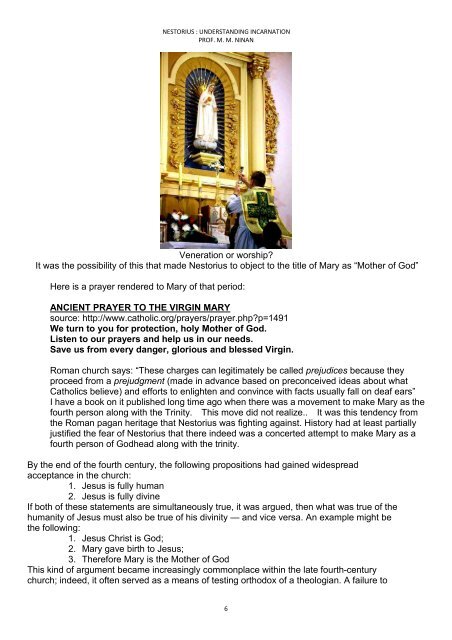Nestorius
Create successful ePaper yourself
Turn your PDF publications into a flip-book with our unique Google optimized e-Paper software.
NESTORIUS : UNDERSTANDING INCARNATION<br />
PROF. M. M. NINAN<br />
Veneration or worship?<br />
It was the possibility of this that made <strong>Nestorius</strong> to object to the title of Mary as “Mother of God”<br />
Here is a prayer rendered to Mary of that period:<br />
ANCIENT PRAYER TO THE VIRGIN MARY<br />
source: http://www.catholic.org/prayers/prayer.php?p=1491<br />
We turn to you for protection, holy Mother of God.<br />
Listen to our prayers and help us in our needs.<br />
Save us from every danger, glorious and blessed Virgin.<br />
Roman church says: “These charges can legitimately be called prejudices because they<br />
proceed from a prejudgment (made in advance based on preconceived ideas about what<br />
Catholics believe) and efforts to enlighten and convince with facts usually fall on deaf ears”<br />
I have a book on it published long time ago when there was a movement to make Mary as the<br />
fourth person along with the Trinity. This move did not realize.. It was this tendency from<br />
the Roman pagan heritage that <strong>Nestorius</strong> was fighting against. History had at least partially<br />
justified the fear of <strong>Nestorius</strong> that there indeed was a concerted attempt to make Mary as a<br />
fourth person of Godhead along with the trinity.<br />
By the end of the fourth century, the following propositions had gained widespread<br />
acceptance in the church:<br />
1. Jesus is fully human<br />
2. Jesus is fully divine<br />
If both of these statements are simultaneously true, it was argued, then what was true of the<br />
humanity of Jesus must also be true of his divinity — and vice versa. An example might be<br />
the following:<br />
1. Jesus Christ is God;<br />
2. Mary gave birth to Jesus;<br />
3. Therefore Mary is the Mother of God<br />
This kind of argument became increasingly commonplace within the late fourth-century<br />
church; indeed, it often served as a means of testing orthodox of a theologian. A failure to<br />
6

















